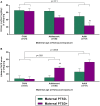Maternal Age at Holocaust Exposure and Maternal PTSD Independently Influence Urinary Cortisol Levels in Adult Offspring
- PMID: 25071719
- PMCID: PMC4081836
- DOI: 10.3389/fendo.2014.00103
Maternal Age at Holocaust Exposure and Maternal PTSD Independently Influence Urinary Cortisol Levels in Adult Offspring
Abstract
Background: Parental traumatization has been associated with increased risk for the expression of psychopathology in offspring, and maternal posttraumatic stress disorder (PTSD) appears to increase the risk for the development of offspring PTSD. In this study, Holocaust-related maternal age of exposure and PTSD were evaluated for their association with offspring ambient cortisol and PTSD-associated symptom expression.
Method: Ninety-five Holocaust offspring and Jewish comparison subjects received diagnostic and psychological evaluations, and 24 h urinary cortisol was assayed by RIA. Offspring completed the parental PTSD questionnaire to assess maternal PTSD status. Maternal Holocaust exposure was identified as having occurred in childhood, adolescence, or adulthood and examined in relation to offspring psychobiology.
Results: Urinary cortisol levels did not differ for Holocaust offspring and comparison subjects but differed significantly in offspring based on maternal age of exposure and maternal PTSD status. Increased maternal age of exposure and maternal PTSD were each associated with lower urinary cortisol in offspring, but did not exhibit a significant interaction. In addition, offspring PTSD-associated symptom severity increased with maternal age at exposure and PTSD diagnosis. A regression analysis of correlates of offspring cortisol indicated that both maternal age of exposure and maternal PTSD were significant predictors of lower offspring urinary cortisol, whereas childhood adversity and offspring PTSD symptoms were not.
Conclusion: Offspring low cortisol and PTSD-associated symptom expression are related to maternal age of exposure, with the greatest effects associated with increased age at exposure. These effects are relatively independent of the negative consequences of being raised by a trauma survivor. These observations highlight the importance of maternal age of exposure in determining a psychobiology in offspring that is consistent with increased risk for stress-related pathology.
Keywords: Holocaust; PTSD; cortisol; intergenerational; maternal; offspring; risk; trauma.
Figures



References
Grants and funding
LinkOut - more resources
Full Text Sources
Other Literature Sources

